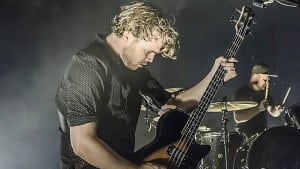With all live concerts on hold due to the COVID-19 pandemic, we decided to re-run this Devon Allman concert review from 2015:
There was a moment on Wednesday night at The Coach House, when bluesman Devon Allman (yes, of those Allmans) left the stage, wandered through the crowd, ordered a drink, came back on stage, took a swig, launched into a towering solo. The crowd may have come out of curiosity, wanting to see if Gregg Allman’s son has any chops, or because they were fans of his dad’s old band, but in that moment, it was clear the people in the crowd were going to leave as fans of Devon Allman.
Allman took to the stage all in black, and used the same guitar the entire show. His band also has an understated presence. They’re unassuming looking guys, but boy do they know how to play. Students and purveyors of the blues, they ripped the lid off of one song after the next, ranging from Allman’s days in Honeytribe and Royal Southern Brotherhood, to his solo albums and covers.
The opener, “Half the Truth” off of Allman’s latest album, Ragged and Dirty, set the tone for the night. A real southern foot-stomper with a menacing guitar riff, it got the crowd’s attention. It wasn’t until the fourth song, an instrumental jam that Devon really began to show his stuff. He put on a clinic, making the guitar shudder and cry. He brought it down to a whisper, then rammed it back up again, looking out at the audience as if to say, “What about this?” The kid came to play.
Showing respect for blues hero Eric Clapton, the band played an impressive cover of “Forever Man,” and even payed tribute to Allman’s heritage with wonderful covers of “Melissa,” and “One Way Out,” a blues standard made famous by the Allman Brothers Band in the 70’s. Interestingly, it was the band’s cover of Bob Marley’s “No Woman, No Cry” that was the real showstopper. The iconic song had everyone swaying, and the band played it with just as much soul as the original. Bobby Schneck Jr., the band’s other guitar player played one of those solos that could make you cry, then Allman brought it home with a solo that went so quiet, he had the crowd hanging on every twitch of this finger.
The band played until midnight, taking a short break which thinned out the crowd to nearly half, making the small setting even more intimate, and appropriately bluesy. The band closed with “Midnight Lake Michigan,” a “spooky blues” instrumental track that Allman introduced by addressing the crowd, saying, “Thank you for supporting real music, made by real people, not drum machines and robots.” The crowd hooted in approval, as Allman made his way through the crowd mid-song, shaking hands and playing another transcendent solo. If you want to see a great guitar player, go see Devon Allman.










